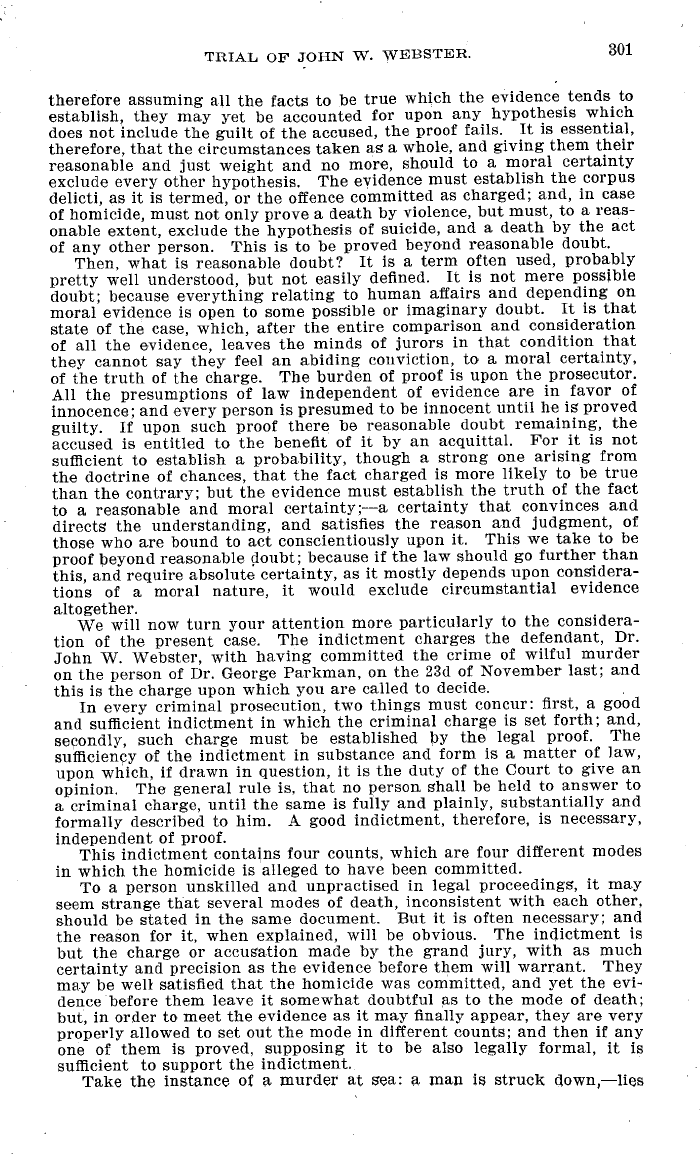|
TRIAL OF JOHN W. WEBSTER. 301
therefore assuming all the facts to be true which the evidence tends to
establish, they may yet be accounted for upon any hypothesis which
does not include the guilt of the accused, the proof fails. It is essential,
therefore, that the circumstances taken as a whole, and giving them their
reasonable and just weight and no more, should to a moral certainty
exclude every other hypothesis. The evidence must establish the corpus
delicti, as it is termed, or the offence committed as charged; and, in case
of homicide, must not only prove a death by violence, but must, to a reas-
onable extent, exclude the hypothesis of suicide, and a death by the act
of any other person. This is to be proved beyond reasonable doubt.
Then, what is reasonable doubt? It is a term often used, probably
pretty well understood, but not easily defined. It is not mere possible
doubt; because everything relating to human affairs and depending on
moral evidence is open to some possible or imaginary doubt. It is that
state of the case, which, after the entire comparison and consideration
of all the evidence, leaves the minds of jurors in that condition that
they cannot say they feel an abiding conviction, to a moral certainty,
of the truth of the charge. The burden of proof is upon the prosecutor.
All the presumptions of law independent of evidence are in favor of
innocence; and every person is presumed to be innocent until he is proved
guilty. If upon such proof there be reasonable doubt remaining, the
accused is entitled to the benefit of it by an acquittal. For it is not
sufficient to establish a probability, though a strong one arising from
the doctrine of chances, that the fact charged is more likely to be true
than the contrary; but the evidence must establish the truth of the fact
to a reasonable and moral certainty;--a certainty that convinces and
directs the understanding, and satisfies the reason and judgment, of
those who are bound to act conscientiously upon it. This we take to be
proof beyond reasonable doubt; because if the law should go further than
this, and require absolute certainty, as it mostly depends upon considera-
tions of a moral nature, it would exclude circumstantial evidence
altogether.
We will now turn your attention more particularly to the considera-
tion of the present case. The indictment charges the defendant, Dr.
John W. Webster, with having committed the crime of wilful murder
on the person of Dr. George Parkman, on the 23d of November last; and
this is the charge upon which you are called to decide.
In every criminal prosecution, two things must concur: first a good
and sufficient indictment in which the criminal charge is set forth; and,
secondly, such charge must be established by the legal proof. The
sufficiency of the indictment in substance and form is a matter of law,
upon which, if drawn in question, it is the duty of the Court to give an
opinion. The general rule is, that no person shall be held to answer to
a criminal charge, until the same is fully and plainly, substantially and
formally described to him. A good indictment, therefore, is necessary,
independent of proof.
This indictment contains four counts, which are four different modes
in which the homicide is alleged to have been committed.
To a person unskilled and unpractised in legal proceedings, it may
seem strange that several modes of death, inconsistent with each other,
should be stated in the same document. But it is often necessary; and
the reason for it, when explained, will be obvious. The indictment is
but the charge or accusation made by the grand jury, with as much
certainty and precision as the evidence before them will warrant. They
may be well satisfied that the homicide was committed, and yet the evi-
dence before them leave it somewhat doubtful as to the mode of death;
but, in order to meet the evidence as it may finally appear, they are very
properly allowed to set out the mode in different counts; and then if any
one of them is proved, supposing it to be also legally formal, it is
sufficient to support the indictment.
Take the instance of a murder at sea: a man is struck down,-lies
|

